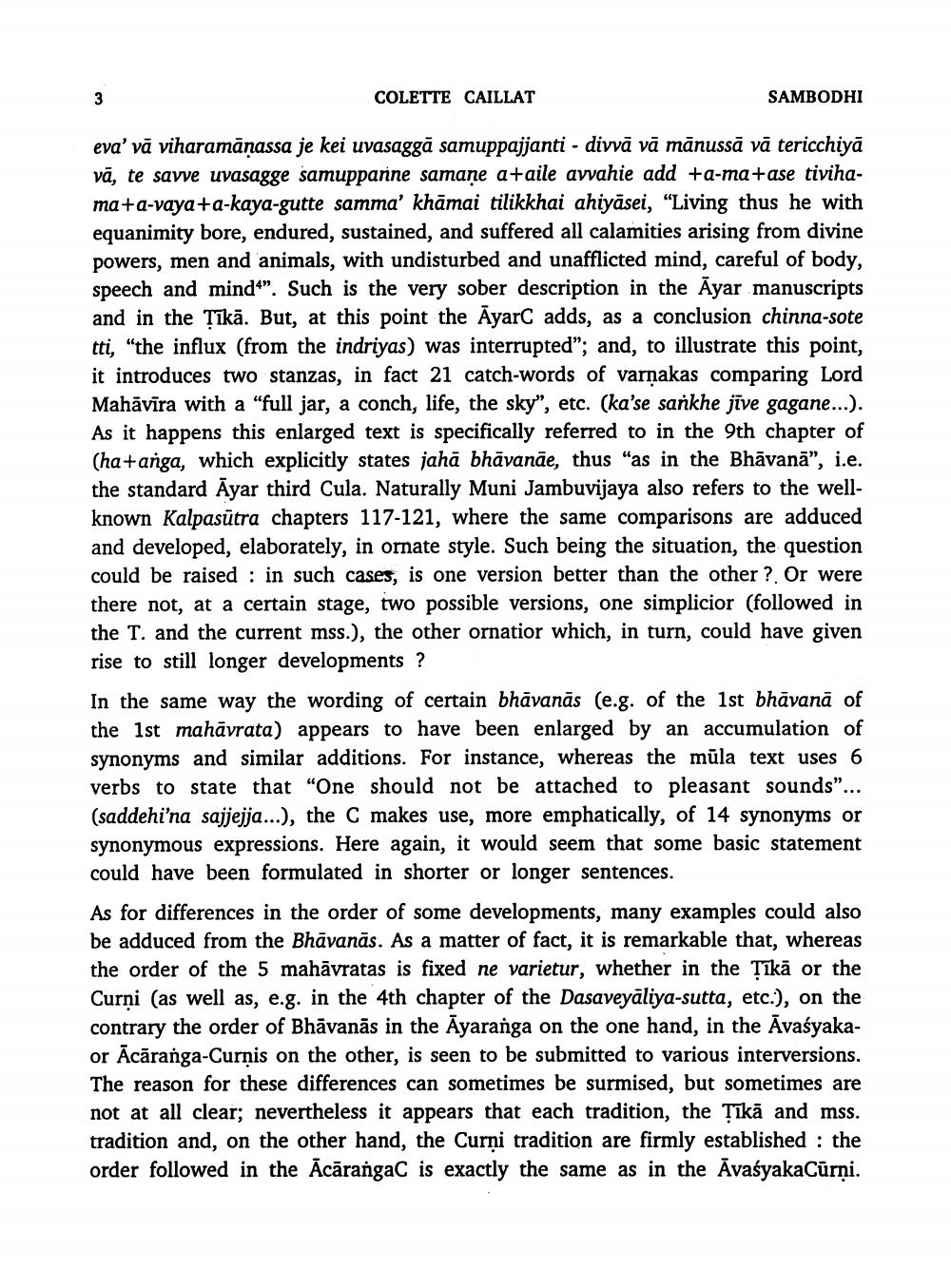Book Title: Sambodhi 1998 Vol 21 Author(s): J B Shah, N M Kansara Publisher: L D Indology Ahmedabad View full book textPage 8
________________ 3 COLETTE CAILLAT SAMBODHI eva' vā viharamāṇassa je kei uvasaggā samuppajjanti - divvā vā mānussā vā tericchiyā vā, te savve uvasagge samuppanne samane a+aile avvahie add +a-ma+ase tivihama+a-vaya+a-kaya-gutte samma' khāmai tilikkhai ahiyāsei, "Living thus he with equanimity bore, endured, sustained, and suffered all calamities arising from divine powers, men and animals, with undisturbed and unafflicted mind, careful of body, speech and mind4". Such is the very sober description in the Ayar manuscripts and in the Ṭīkā. But, at this point the AyarC adds, as a conclusion chinna-sote tti, "the influx (from the indriyas) was interrupted"; and, to illustrate this point, it introduces two stanzas, in fact 21 catch-words of varṇakas comparing Lord Mahāvīra with a "full jar, a conch, life, the sky", etc. (ka'se sankhe jive gagane...). As it happens this enlarged text is specifically referred to in the 9th chapter of (ha+anga, which explicitly states jahā bhāvanãe, thus "as in the Bhāvanā", i.e. the standard Ayar third Cula. Naturally Muni Jambuvijaya also refers to the wellknown Kalpasūtra chapters 117-121, where the same comparisons are adduced and developed, elaborately, in ornate style. Such being the situation, the question could be raised in such cases, is one version better than the other?. Or were there not, at a certain stage, two possible versions, one simplicior (followed in the T. and the current mss.), the other ornatior which, in turn, could have given rise to still longer developments ? In the same way the wording of certain bhāvanās (e.g. of the 1st bhāvanā of the 1st mahāvrata) appears to have been enlarged by an accumulation of synonyms and similar additions. For instance, whereas the mula text uses 6 verbs to state that "One should not be attached to pleasant sounds"... (saddehi'na sajjejja...), the C makes use, more emphatically, of 14 synonyms or synonymous expressions. Here again, it would seem that some basic statement could have been formulated in shorter or longer sentences. As for differences in the order of some developments, many examples could also be adduced from the Bhāvanās. As a matter of fact, it is remarkable that, whereas the order of the 5 mahāvratas is fixed ne varietur, whether in the Țikā or the Curņi (as well as, e.g. in the 4th chapter of the Dasaveyaliya-sutta, etc.), on the contrary the order of Bhāvanās in the Ayaranga on the one hand, in the Avaśyakaor Acaranga-Curņis on the other, is seen to be submitted to various interversions. The reason for these differences can sometimes be surmised, but sometimes are not at all clear; nevertheless it appears that each tradition, the Ṭīkā and mss. tradition and, on the other hand, the Curni tradition are firmly established: the order followed in the AcarangaC is exactly the same as in the AvaśyakaCūrṇi.Page Navigation
1 ... 6 7 8 9 10 11 12 13 14 15 16 17 18 19 20 21 22 23 24 25 26 27 28 29 30 31 32 33 34 35 36 37 38 39 40 41 42 43 44 45 46 47 48 49 50 51 52 53 54 55 56 57 58 59 60 61 62 63 64 65 66 67 68 69 70 71 72 73 74 75 76 77 78 79 80 81 82 ... 196
